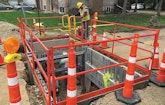
By dedicating time to a safety program that includes job site toolbox talks, utilities can provide an out-of-the-classroom overview of the regulations, as well as a review of the hazards, to help keep workers safe.
Interested in Safety?
Get Safety articles, news and videos right in your inbox! Sign up now.
Safety + Get AlertsIt’s easy to cut corners while excavating or working in trenches, but it’s hard to bring a life back.
United Rentals has more than 92 trench safety locations and the largest fleet of shoring and underground excavation rental equipment in North America. The company knows trench safety, and it has compiled some toolbox talk topics to help increase worker knowledge about trench hazards and safe work practices in trenching and excavation operations.
“Safety is our No. 1 priority at United Rentals,” says Todd Hayes, Trench Safety regional vice president. “We engage our customers to help mitigate risk and improve production on underground construction projects by providing education and training about regulations, along with a partnership on shoring solutions. By dedicating time to a safety program that includes job site toolbox talks, companies provide an out of the classroom overview of the regulations, as well as a review of the hazards, and a plan to protect every employee from those hazards so they can work safely in and around trenches and excavations.”
Choosing the right topics for toolbox talks — informal, topic-specific, short-format meetings to convey important safety messages — will bolster trench safety understanding among your crew. Here are a few ideas to get the ball rolling and help keep safety top of mind with workers.
Protecting Installations. Existing utilities are everywhere, and hitting them while digging is extremely hazardous. Scratching the coating on a gas pipeline can cause line failure. Hitting fiber optic lines can cause severe disruption to every industry. Damage prevention is key. Make sure to call a locate service through 811, which is the national call-before-you-dig phone number. Even if the project is on private property where the property owner does not own the utility, and even if it is in a submerged setting like a swamp or a lake. Know the state law regarding how much time to give to owners to respond, and a locate service will come out and mark the approximate location of those utilities. Even when the lines have been marked, use care when digging around any utility so as to not disturb or damage the line. Fines for digging without having called for the appropriate locates are significant even if nothing is hit. Know the law and refer to OSHA Standard 1926 Subpart P — call before digging.
Provide Proper Access and Egress. In every trench of 4 or more feet in depth, a ramp, ladder or other safe means of access and egress must be in place any time employees are in a trench. An employee must be able to exit a trench safely at any time without depending on assistance from someone else to get out. In a trench excavation, point of egress must be within 25 feet of every worker, according to OSHA Standard 1926 Subpart P. If an earthen ramp is the access/egress choice, the employee must not be exposed to a potential cave-in and the earthen ramp must allow for the employee to enter and exit in a normal, upright orientation. Likewise, if a ladder is the choice, the employee must be able to access the ladder without being put at risk of a cave-in.
Test for Hazardous Atmospheres. Trenches and excavations are not automatically considered confined spaces, according to OSHA Trench and Excavation Safety. In every trench or excavation that is 4 or more feet in depth, where there is a potential for a hazardous atmosphere to exist, then that atmosphere must be tested. The tests would include oxygen deficiency or enrichment and testing the atmosphere for flammable gas concentrations that would be in excess of 20% of the lower flammable limit of the gas. Where those situations are found, adequate ventilation is required to reduce the atmospheric contaminants to an acceptable level, and testing shall continue as needed to ensure the atmosphere remains safe. Also, emergency rescue equipment (davit arms, basket stretchers, harnesses) shall be readily available where hazardous atmospheres exist, or could develop, during the work. Most would think it reasonable to find a potential for hazardous atmospheres while performing sewer work. If there are unique gases in an environment, like a refinery or chemical plant, ensure that monitors are configured to test for those gases.
Performing Inspections. Before the beginning of work, or during work after a hazard-increasing event takes place, the competent person shall perform an inspection of the protective system and the adjacent area and test the atmosphere to ensure no hazardous conditions exist. Where hazards are found, the competent person shall ensure that corrective measures are taken to eliminate the hazards prior to the restart of the work. What could be a hazard-increasing event? It could be the addition of a significant surcharge, movement of a protective system, a rainstorm, a nearby gas leak or a breach of a sewer line, just to name a few. Refer to OSHA Standard 1926 Subpart P for more details.
Providing Fall Protection. When an employee is permitted or allowed to cross over a trench, and the depth of the trench is 6 feet or more, then a walkway with guardrails 42 inches high (+/- 3 inches), midrails at least 21 inches high, and meeting the other specific requirements in OSHA Fall Protection found in 1926.502(b) must be used. Also, if the trench is not readily visible due to any visual barrier, then fall protection must be provided and must meet the requirements found in OSHA 1926.502. Refer to OSHA Standard 1926 Subparts P and M for more information.








